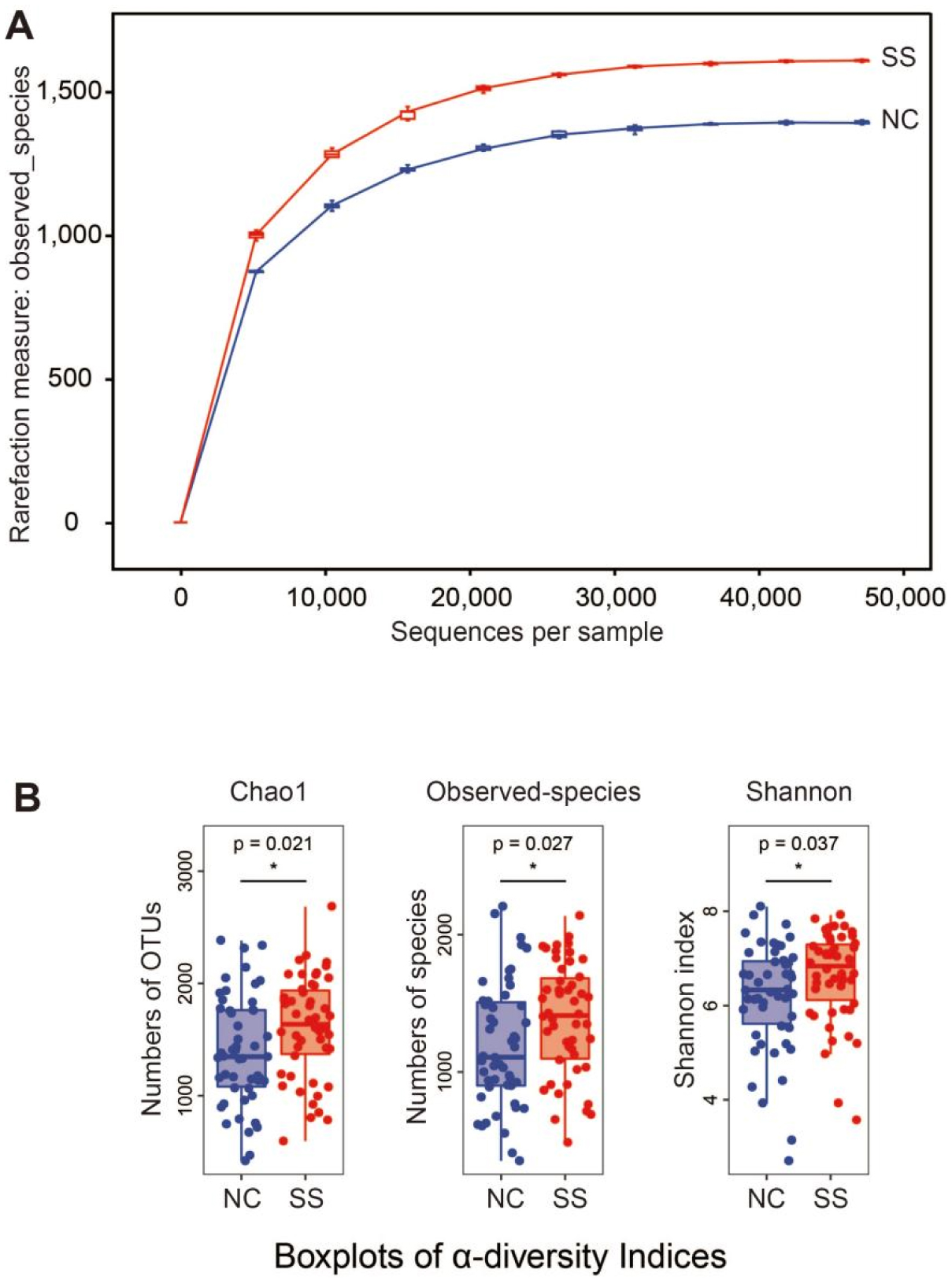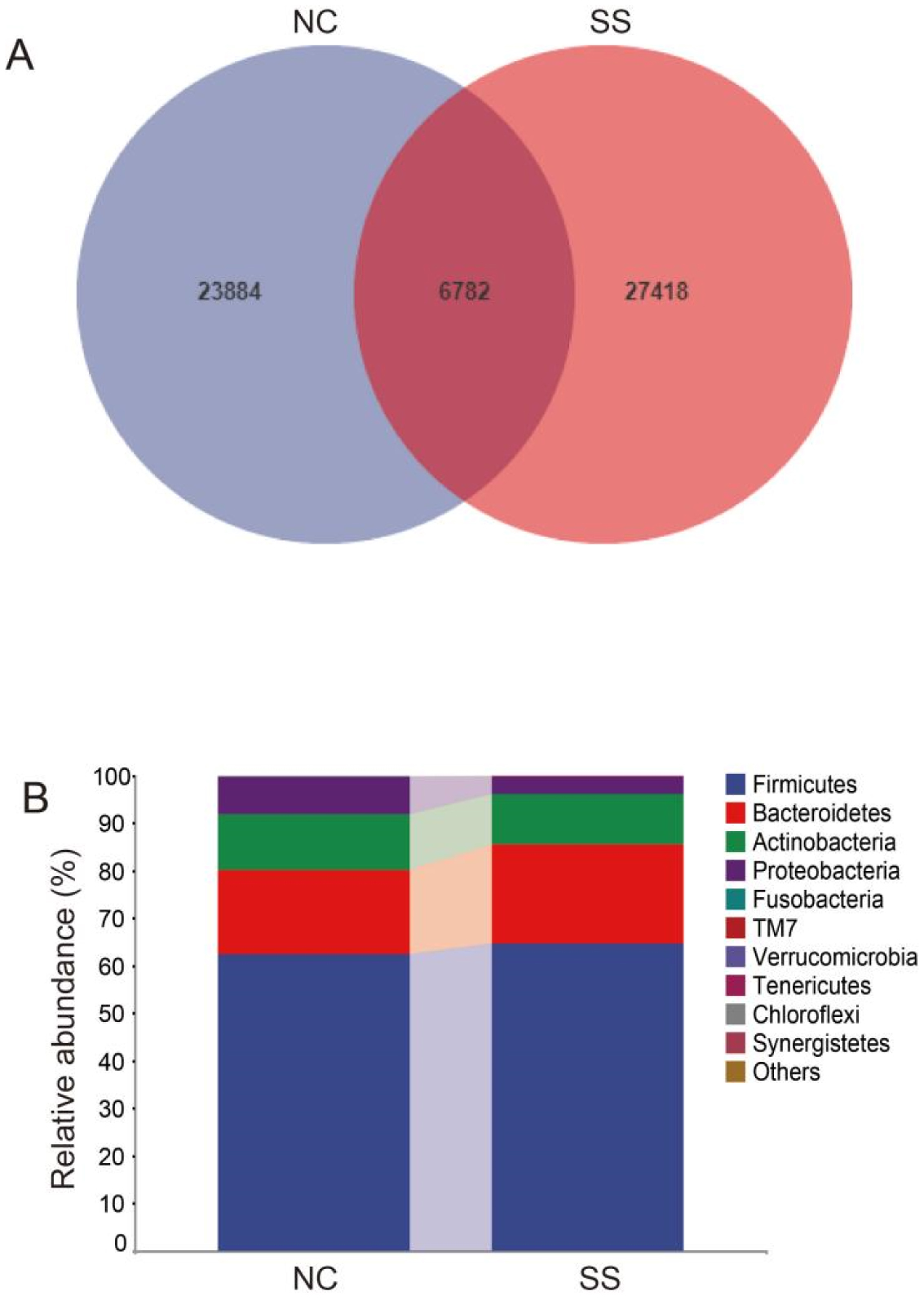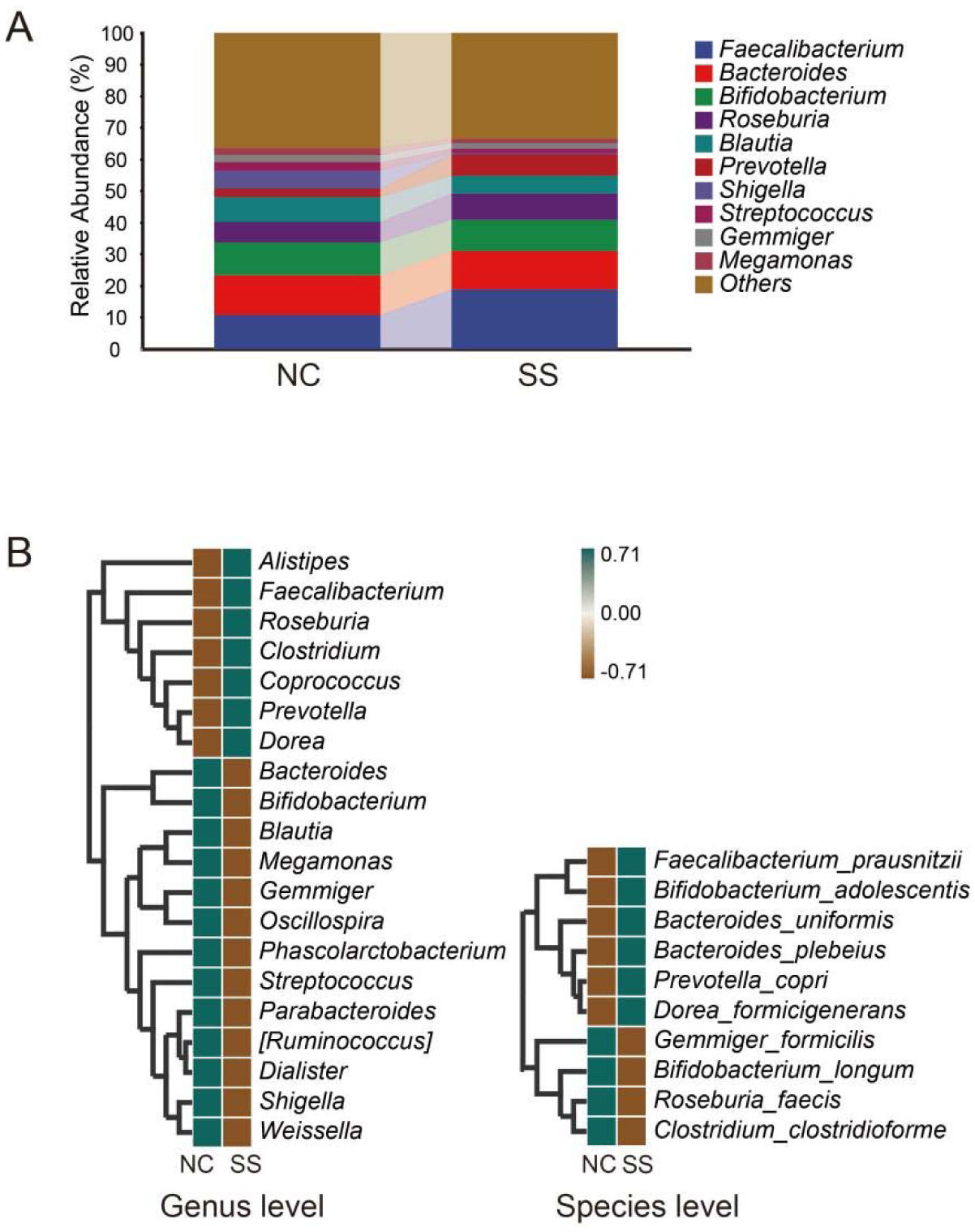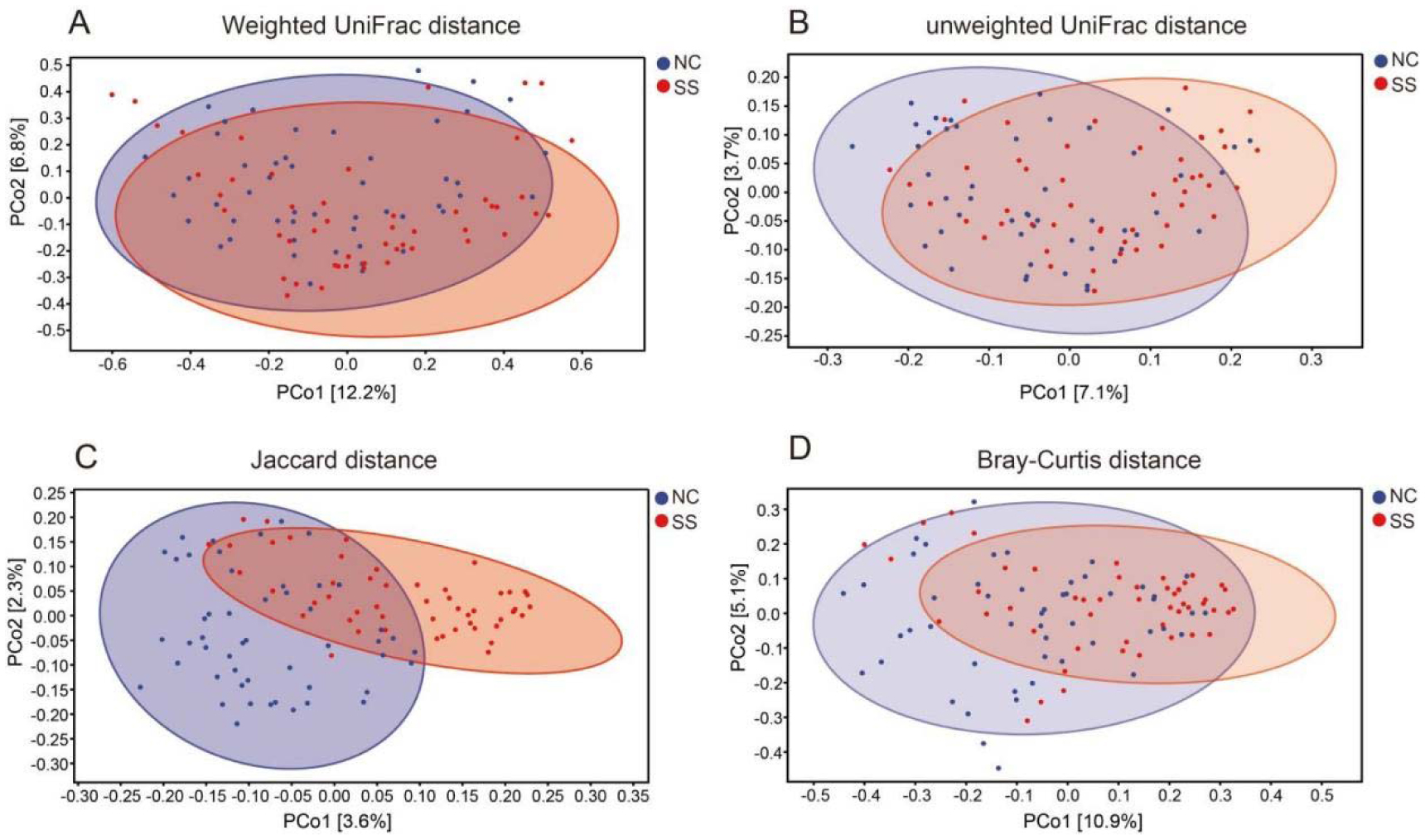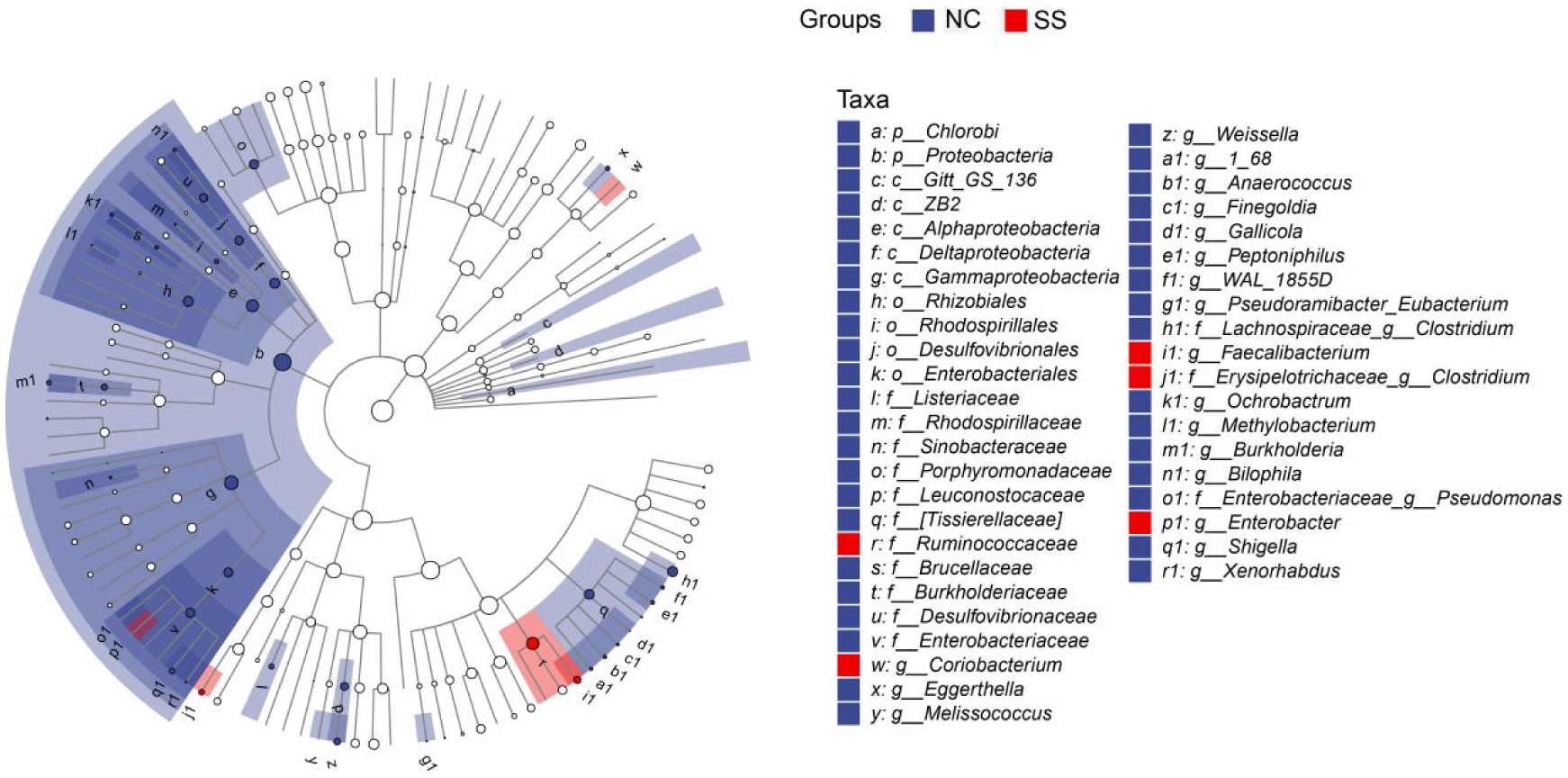Physical exercise contributes to good health and affects gut microbiota. We investigated the gut microbiota features of students majoring in sports. Fecal samples were collected from the sports majors (SS group, 50 students, 11 males, and 39 females, 18.7 ± 0.8 years old) and non-sports majors (NC group, 50 students, 23 males, and 27 females, 19.0 ± 1.0 years old) for high-throughput sequencing analysis. Their clinical data were statistically analyzed. The results showed that the gut microbiota compositions are similar in evolution and development, and significant differences were observed in the proportion of rare species, such as Fusobacterium, Mitsuokella, Acidaminococcus, and Butyricicoccus. Compared with the NC group, the SS group exhibited a more diverse gut microbiota, with a high abundance of Alistipes, Faecalibacterium, Roseburia, Prevotella, etc., at the genus level, as well as Faecalibacterium prausnitzii, Bifidobacterium adolescentis, Bacteroides uniformis, and Bacteroides plebeius at the species level. The research shows that long-term physical exercise or training can enhance gut microbiota diversity and boost beneficial bacteria, which are conducive to intestinal environmental conditions.
1.
Introduction
Gut microbiota plays a vital role in human health and can be influenced by multiple factors, such as genetics, exercise, diet, and the external environment [1],[2]. Regarding exercise, which is a common way to improve health, regular physical activities contribute to better gut microbiota. In 2014, Clarke pioneeringly explored the link between physical excise (PE) and gut microbiota, demonstrating PE's potential to increase the diversity of human intestinal microbiota [3] and improve their health status. Physical exercise provides health benefits, such as protection against chronic diseases and improved life quality, and gut microbiota might be involved in many beneficial effects.
Subsequent investigations into the effects of PE on the composition and function of gut microbiota were conducted in animal models [4] and humans [5]. It was proven that the effects of interest occurred regardless of factors such as diets, body composition (lean or obese), and exercise levels (sedentary subjects). It has been reported that exercise can increase beneficial microbiota species and enhance microbiota diversity [6]. The top Polish endurance athletes have more diverse gut microbiota and a higher content of beneficial bacteria than the sedentary controls [7]. Based on these studies, it can be concluded that exercise can improve human fitness, including gut microbiota. In addition, young people are considered to have healthier gut microbiota than the elderly. The young population with long-term exercise is considered a representative group of healthy gut microbiota, such as young athletes.
To bridge this knowledge gap, we summarized and compared the features of sports students (high-intensity exercise) with those of non-sports students (usually inactivity). The findings provide more information and details about the composition and function of healthy gut microbiota, which is insightful for identifying beneficial bacteria for human health.
2.
Materials and methods
2.1. Participants
All participants were attending Northeast Normal University of Changchun City, Jilin Province, China. They were divided equally (n = 50) into sports major (SS) and control (NC) groups. The number of subjects was determined according to the previous study [7]. On average, 39 women and 11 men aged 17–20 who exercised for less than 10 min per day were included in the NC group. SS group consisted of 27 female and 23 male students aged from 18 to 21 years old, all classified as national Level II athletes according to the technical grade standards for track and field athletes. The basic information of participants is listed in Table 1. The participants were informed, agreed with the research content, and cooperated voluntarily. In addition, subjects with chronic diseases (such as diabetes, high blood pressure, heart disease, gout, and hyperlipidemia) were excluded. The study was conducted and approved following the ethics committee of Northeast Normal University (No. Nenu20211022-01). Fecal samples from each participant were collected separately and stored in sterile tubes at −80 °C.
2.2. DNA extraction and 16S rRNA analysis
The extraction of total DNA followed the method in another report [8]. Total bacterial genomic DNA (100 mg fecal samples) was prepared using the Fast DNA SPIN Extraction Kit (MP Biomedicals, Santa Ana, CA, USA) and measured with a NanoDrop ND-1000 Spectrophotometer (Thermo Fisher Scientific, Waltham, MA, USA) and agarose gel electrophoresis. The V3-V4 region of the 16S rRNA gene was amplified using a forward primer (5′-ACTCCTACGGGAGGCAGCA-3′) and a reverse primer (5′-GGACTACHVGGGTWTCTAAT-3′). The PCR products were separated by gel electrophoresis and purified with the AxyPrep DNA Gel Extraction Kit (AP-GX-500; Axygen, New York, USA). The DNA library was constructed using the TruSeq Nano DNA LT Library Prep Kit (FC-121-4001; Illumina, San Diego, USA). The Quant-iT PicoGreen dsDNA Assay Kit was employed to quantify the library on the Promega QuantiFluor System. The optimized library was tested using the Agilent High Sensitivity DNA Kit (5067-4626; Agilent, California, USA) and sequenced using the IlluminaMiSeq System.
Sequence data analyses were mostly performed using QIIME2 and R packages (v2.15.3). Alpha diversity indices, such as Chao1 richness estimator, Observed species, and Shannon diversity index, were calculated using the ASV table in QIIME2, and visualized as box plots [9]. ASV-level ranked abundance curves were generated to compare the richness and evenness of ASVs among samples. Beta diversity analysis was performed to investigate the structural variation of microbial communities across samples using Jaccard metrics, Bray-Curtis metrics and UniFrac distance metrics and visualized via principal coordinate analysis (PCoA), nonmetric multidimensional scaling (NMDS) and unweighted pair-group method with arithmetic means (UPGMA) hierarchical clustering [10]. A Venn diagram was generated to visualize the shared and unique ASVs among samples or groups using R package “VennDiagram” based on the occurrence of ASVs across samples/groups regardless of their relative abundance. Taxa abundances at the ASV levels were statistically compared among samples or groups by MetagenomeSeq, and visualized as Manhattan plots. LEfSe (Linear discriminant analysis effect size) was performed to detect differentially abundant taxa across groups using the default parameters. All raw sequences were deposited into the NCBI Sequence Read Archive (SRP492999).
2.3. Statistical analysis
Statistical analysis was performed using GraphPad Prism 5.0. t test analysis was introduced to compare differences between groups. All data are expressed as the mean ± standard deviation (SD). Significance is defined as P < 0.05.
3.
Results
3.1. Sequencing analysis
On average, each sample generated 105, 065 reads, which passed the quality filtering thresholds. The rarefaction curves and estimators in each group are shown in Figure 1A. The rarefaction curves indicate that the gut microbiota sequencing depth is captured at desired levels and can be used for further analysis.
3.2. α-Diversity results
Boxplots of α-diversity indices are depicted in Fig. 1B. Significant differences are observed in Chao 1, observed species, and Shannon indices between groups (P = 0.021, 0.027, and 0.037, respectively). This observation reveals a greater diversity of gut microbiota in SS than in NC. Moreover, the SS group has a richer species composition, with a greater number of OTUs and rare species.
3.3. OTU composition analysis
Based on the 16S rRNA sequencing analysis results, the OTUs were used for further research. The two groups shared 6782 common OTUs; the NC group had 23884 unique OTUs, while the SS group possessed 27418 distinct OTUs (Figure 2A).
3.4. Composition analysis of gut microbiota
The relative enrichment of gut microbiota classification units is presented as a stacked histogram. At the phylum level, both groups mostly consist of Firmicutes, Bacteroidetes, Actinobacteria, and Protebacteria (Figure 2B). Compared to NC, SS group exhibits a higher relative abundance of Firmicutes and Bacteroidetes.
Figure 3A illustrates the differences in the relative abundance of bacteria at the genus level. The gut microbiota in the two groups mostly comprise Faecalibacterium, Bacteroides, Bifidobacterium, Roseburia, Blautia, Prevotella, Shigella, Streptococcus, Gemmiger, and Megamonas. Subsequently, we analyze the species differences and marker species to distinguish gut microbiota between the two groups. The heat map of species composition at the genus and species levels is shown in Figure 3B. It can be observed that the gut microbiota of the SS group exhibits a high abundance of Alistipes, Faecalibacterium, Roseburia, Clostridium, Coprococcus, Prevotella, Dorea at the genus level as well as Faecalibacterium prausnitzii, Bifidobacterium adolescentis, Bacteroides uniformis, Bacteroides plebeius, Prevotella copri, and Dorea formicignerans at the species level. In contrast, the NC gut microbiota is abundant in Bacteroides, Bifidobacterium, Blautia, Megamonas, Gemmiger, Oscillospira, Phascolarctobacterium, Streptococcus, Parabacteroides, Dialister, Shigella, and Weissella at the genus level, along with Gemmiger formicilis, Bifidobacterium longum, Roseburia faecis, and Clostridium clostridioforme at the species level.
3.5. β-Diversity analysis
β-diversity was introduced to explore the similarity of gut microbiota between the two groups. The weighted and unweighted analyses reveal that the gut microbiota compositions of the two groups are identical in evolution and development (Figure 4A,B). Despite such similarities, significant differences are found in the proportion of rare species (Figure 4C) and species richness (Figure 4D). These results indicate that the diversity and composition of gut microbiota between the two populations are similar, particularly in bacterial diversity and composition with relatively high abundance.
3.6. LefSe analysis
LefSe analysis (Figure 5) was applied to simultaneous difference analysis for all taxonomic levels to look for robust differential species between groups. The results show that in the SS group, the microbiota with higher abundance are Ruminococcaceae and Erysipelotrichaceae at the family level, while Coriobacterium, Faecalibacterium, and Enterobacter were at the genus level, which were the potential biomarker microbiota associated with sport major students.
4.
Discussion
Young people are considered healthy and full of vitality. It is widely accepted that moderate exercise is beneficial and affects gut microbiota [11],[12]. In this study, sports and non-sports majors students are characterized by elevated richness and diversity of gut microbiota (Figure 1). The SS group has more diverse gut microbiota than the NC group, potentially due to their intensified physical training. This observation exhibits agreement with other reports [13],[14]. Typically, a higher level of gut microbiota α-diversity indicates a healthier status, while a lower value is often associated with diseases such as type 1 diabetes [15] and rheumatoid arthritis [16]. Higher gut microbiota diversity can prevent intestinal destruction caused by external environment variations and maintain a healthy intestinal micro-environment [17].
Considering that both groups are healthy young people, we focus on the species differences. No obvious differences are detected at the phylum level. At the genus level, the gut microbiota of the sports major group is relatively abundant in short-chain fatty acid-producing bacteria [18],[19], such as Faecalibacterium, Roseburia, Coprococcus, and Prevotella (Figure 3), which is generally believed to be beneficial to human health. The beneficial bacteria are also observed in sports majors at the species level. For example, the Faecalibacterium prausnitzii within the Clostridiaceae-Firmicutes are common “friendly” bacteria in human intestines [20]. This bacterium is one of the most abundant intestinal microbes in healthy people and is essential in various metabolic processes of the host. The change in the quantity of Faecalibacterium prausnitzii is reportedly related to intestinal diseases. Some research on this microorganism reported its anti-inflammatory effects, which greatly improve intestinal inflammation, as well as its involvement in the control of obesity [21]. Bifidobacterium adolescentis is a bacterial community ubiquitous in the intestinal tract of young people. Our study reveals that Bifidobacterium adolescentis is abundant in the fecal samples of sports major students (Figure 3). It has been reported that this bacterium exerted positive effects on chronic diarrhea, constipation, and anti-aging, contributing to the addition of this beneficial bacterium in food to improve the healthy benefits of products [22]. Exercise also increases the quantity of Prevotella copri, which is associated with a reduced risk of allergies and changes in inflammation levels [23],[24]. Exercise was related to a healthy gut status according to recent literature [25],[26]. Intestinal microbiota dysbiosis could compromise the integrity of the intestinal barrier, potentially facilitating virus access into circulating enterocytes and infecting organs [27]. Consequently, these changes could increase the chances of infections and/or symptom exacerbation. Furthermore, the discovery of these beneficial bacteria can promote the application of probiotics in osteoporosis [28],[29] or other metabolic diseases [30].
Despite the insights into the gut microbiota features, this study has limitations. For example, we did not conduct a metabolic analysis or in-depth discussion on the effect of exercise at the metabolic level. In addition, the number of participants is not sufficient for correlation studies. Although the impact of diet and the external environment on gut microbiota is recognized, no diet intervention is used in this research. Accordingly, participants were instructed to maintain their daily eating habits and denied recent use of antibiotics. This may also lead to errors in our results. Researchers need to further address these deficiencies.
5.
Conclusions
In conclusion, we found the differences in gut microbiota diversity and composition between sports and non-sports students and identified key distinct species. Compared with the control group, sports majors exhibit a greater diversity of gut microbiota and a higher abundance of Alistipes, Faecalibacterium, ect., at the genus level, as well as Faecalibacterium prausnitzii and Bifidobacterium adolescentis at the species level. However, the mechanism for this specific difference needs further investigation. This research can provide insights into healthier gut microbiota.
Use of AI tools declaration
The authors declare they have not used Artificial Intelligence (AI) tools in the creation of this article.









 DownLoad:
DownLoad:
